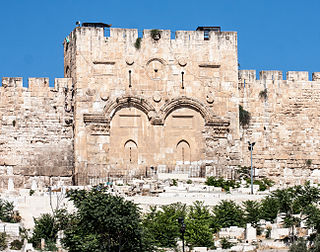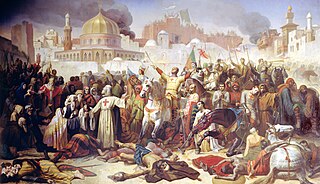Related Research Articles

The First Crusade (1096–1099) was the first of a series of religious wars, or Crusades, initiated, supported and at times directed by the Latin Church in the Middle Ages. The objective was the recovery of the Holy Land from Islamic rule. While Jerusalem had been under Muslim rule for hundreds of years, by the 11th century the Seljuk takeover of the region threatened local Christian populations, pilgrimages from the West, and the Byzantine Empire itself. The earliest initiative for the First Crusade began in 1095 when Byzantine emperor Alexios I Komnenos requested military support from the Council of Piacenza in the empire's conflict with the Seljuk-led Turks. This was followed later in the year by the Council of Clermont, during which Pope Urban II supported the Byzantine request for military assistance and also urged faithful Christians to undertake an armed pilgrimage to Jerusalem.

The Golden Gate or Gate of Mercy is the only eastern gate of the Temple Mount, and one of only two Gates of the Old City of Jerusalem that used to offer access into the city from the East side.

Krak des Chevaliers is a medieval castle in Syria and one of the most important preserved medieval castles in the world. The site was first inhabited in the 11th century by Kurdish troops garrisoned there by the Mirdasids. In 1142 it was given by Raymond II, Count of Tripoli, to the order of the Knights Hospitaller. It remained occupied by them until it was reconquered by the Muslims in 1271.

The siege of Jerusalem marked the end of the First Crusade, whose objective was Christian control of the city of Jerusalem and removing the Church of the Holy Sepulchre from Islamic control. The five-week siege began on 7 June 1099 and was carried out by the Christian forces of Western Europe mobilized by Pope Urban II after the Council of Clermont in 1095. The city had been governed for a century first by the Seljuk Turks and later by the Fatimids. A number of eyewitness accounts of the battle were recorded, including in the anonymous chronicle Gesta Francorum.

Tancred was an Italo-Norman leader of the First Crusade who later became Prince of Galilee and regent of the Principality of Antioch. Tancred came from the house of Hauteville and was the great-grandson of Norman lord Tancred of Hauteville.

The People's Crusade was the beginning phase of the First Crusade whose objective was to retake the Holy Land, and Jerusalem in particular, from Islamic rule. In 1095, after the head of the Roman Catholic Church Pope Urban II started to urge faithful Christians to undertake an armed pilgrimage to Jerusalem, the People's Crusade was conducted for roughly six months from April to October 1096. It is also known as the Peasants' Crusade, Paupers' Crusade or the Popular Crusade as it was executed by a mainly untrained peasant army prior to the main church-organized crusade. It was led primarily by Peter the Hermit with forces of Walter Sans Avoir. The peasant army of this crusade was destroyed by the forces of the Seljuk Turks under Kilij Arslan at the Battle of Civetot in northwestern Anatolia.

The Rhineland massacres, also known as the German Crusade of 1096 or Gzerot Tatnó, were a series of mass murders of Jews perpetrated by mobs of French and German Christians of the People's Crusade in the year 1096,. These massacres are often seen as the first in a sequence of antisemitic events in Europe which culminated in the Holocaust.

The siege of Lisbon, from 1 July to 25 October 1147, was the military action against the Almoravid dynasty that brought the city of Lisbon under the definitive control of the new Christian power, the Kingdom of Portugal.

The siege of Jerusalem lasted from 20 September to 2 October 1187, when Balian of Ibelin surrendered the city to Saladin. Earlier that summer, Saladin had defeated the kingdom's army and conquered several cities. Balian was charged with organizing a defense. The city was full of refugees but had few soldiers. Despite this fact the defenders managed to repulse several attempts by Saladin's army to take the city by storm. Balian bargained with Saladin to buy safe passage for many, and the city was peacefully surrendered with limited bloodshed. Though Jerusalem fell, it was not the end of the Kingdom of Jerusalem, as the capital shifted first to Tyre and later to Acre after the Third Crusade. Latin Christians responded in 1189 by launching the Third Crusade led by Richard the Lionheart, Philip Augustus, and Frederick Barbarossa separately. In Jerusalem, Saladin restored Muslim holy sites and generally showed tolerance towards Christians; he allowed Orthodox and Eastern Christian pilgrims to visit the holy sites freely—though Frankish pilgrims were required to pay a fee for entry. The control of Christian affairs in the city was handed over to the patriarch of Constantinople.

The siege of Jacob's Ford was a victory of the Muslim Sultan Saladin over the Christian King of Jerusalem, Baldwin IV. It occurred in August 1179, when Saladin conquered and destroyed Chastelet, a new border castle built by the Knights Templar at Jacob's Ford on the upper Jordan River, a historic passage point between the Golan Heights and north Galilee. Jacob's Ford is also known by the Latin name of Vadum Iacob and in modern Hebrew as Ateret. Many scholars believe that Saladin's reconquest of the Holy Land and Jerusalem in 1187 was heralded by this earlier victory.

The siege of Zara or siege of Zadar was the first major action of the Fourth Crusade and the first attack against a Catholic city by Catholic crusaders. The crusaders had an agreement with Venice for transport across the sea, but the price far exceeded what they were able to pay. Venice set the condition that the crusaders help them capture Zadar, a constant battleground between Venice on one side and Croatia and Hungary on the other, whose king, Emeric, pledged himself to join the Crusade. Although some of the crusaders refused to take part in the siege, the attack on Zadar began in November 1202 despite letters from Pope Innocent III forbidding such an action and threatening excommunication. Zadar fell on 24 November and the Venetians and the crusaders sacked the city. After wintering in Zadar, the Fourth Crusade continued its campaign, which led to the siege of Constantinople.

Mongol raids into Palestine took place towards the end of the Crusades, following the temporarily successful Mongol invasions of Syria, primarily in 1260 and 1300. Following each of these invasions, there existed a period of a few months during which the Mongols were able to launch raids southward into Palestine, reaching as far as Gaza.

The History of Jerusalem during the Kingdom of Jerusalem began with the capture of the city by the Latin Christian forces at the apogee of the First Crusade. At that point it had been under Muslim rule for over 450 years. It became the capital of the Latin Kingdom of Jerusalem, until it was again conquered by the Ayyubids under Saladin in 1187. For the next forty years, a series of Christian campaigns, including the Third and Fifth Crusades, attempted in vain to retake the city, until Emperor Frederick II led the Sixth Crusade and successfully negotiated its return in 1229.

The Venetian Crusade of 1122–1124 was an expedition to the Holy Land launched by the Republic of Venice that succeeded in capturing Tyre. It was an important victory at the start of a period when the Kingdom of Jerusalem would expand to its greatest extent under Baldwin II of Jerusalem. The Venetians gained valuable trading concessions in Tyre. Through raids on Byzantine territory both on the way to the Holy Land and on the return journey, the Venetians forced the Byzantines to confirm, as well as extend, their trading privileges with the empire.

Wine in Palestine has been in production for several years. In the region of Palestine, the use of wine was not only an important factor in Jewish religious ritual, but also a necessity for social interaction, general dietary consumption and medicinal purposes. During the Byzantine period, large-scale production led to international commerce in the commodity, and Palestinian wine was exported around the Mediterranean region. Production by Christians diminished with the Islamic conquest in the 7th century and was temporarily revived with the settlement of Frankish Christians under the Crusades in the 12th-13th centuries. Jews continued to cultivate vineyards in the late 15th century into the Ottoman period. The first modern wineries were established by German settlers at Sarona in 1874/5 and by Jews supported by Baron Edmond de Rothschild from France at Rishon LeZion in 1882.

The Barons' Crusade (1239–1241), also called the Crusade of 1239, was a crusade to the Holy Land that, in territorial terms, was the most successful crusade since the First Crusade. Called by Pope Gregory IX, the Barons' Crusade broadly embodied the highest point of papal endeavor "to make crusading a universal Christian undertaking." Gregory IX called for a crusade in France, England, and Hungary with different degrees of success. Although the crusaders did not achieve any glorious military victories, they used diplomacy to successfully play the two warring factions of the Ayyubid dynasty against one another for even more concessions than Frederick II had gained during the more well-known Sixth Crusade. For a few years, the Barons' Crusade returned the Kingdom of Jerusalem to its largest size since 1187.

The Church of Saint Mary of the Germans was a Catholic church, built in Romanesque style, now in ruins, located in the Old City of Jerusalem on the northeast slope of Mount Zion.
The Wisconsin Collaborative History of the Crusades is a six-volume set on the Crusades through the 16th century, published from 1969 to 1989. The work was a major collaborative effort under the general editorship of American medieval historian Kenneth M. Setton. Begun at the University of Pennsylvania in 1950, the work was finished at the University of Wisconsin, and is generally known as the Wisconsin History. Setton oversaw the work of over sixty specialists, covering 98 topics on the full gamut of Crusader studies, reflecting of the concurrent state of the knowledge, with timelines, gazetteers and indexes. The work may be today regarded as uneven in parts and at times dated, but remains as an important resource in the study of the various aspects of crusading history, with fine maps, bibliographies and toponymic details.
References
- ↑ Reichberg, Gregory M.; Syse, Henrik; Begby, Endre (2006). The ethics of war: classic and contemporary readings. Wiley-Blackwell. p. 102. ISBN 978-1-4051-2377-8.
- ↑ J. S. C. Riley-Smith, Jonathan Phillips, Alan V. Murray, Guy Perry and Nicholas Morton (2016). A Database of Crusaders to the Holy Land, 1095–1149. "Lethold of Tournai".
{{cite web}}: CS1 maint: multiple names: authors list (link) CS1 maint: numeric names: authors list (link) - ↑ Asbridge, Thomas (2004). "The First Crusade, A New History," Oxford University Press. p. 315.